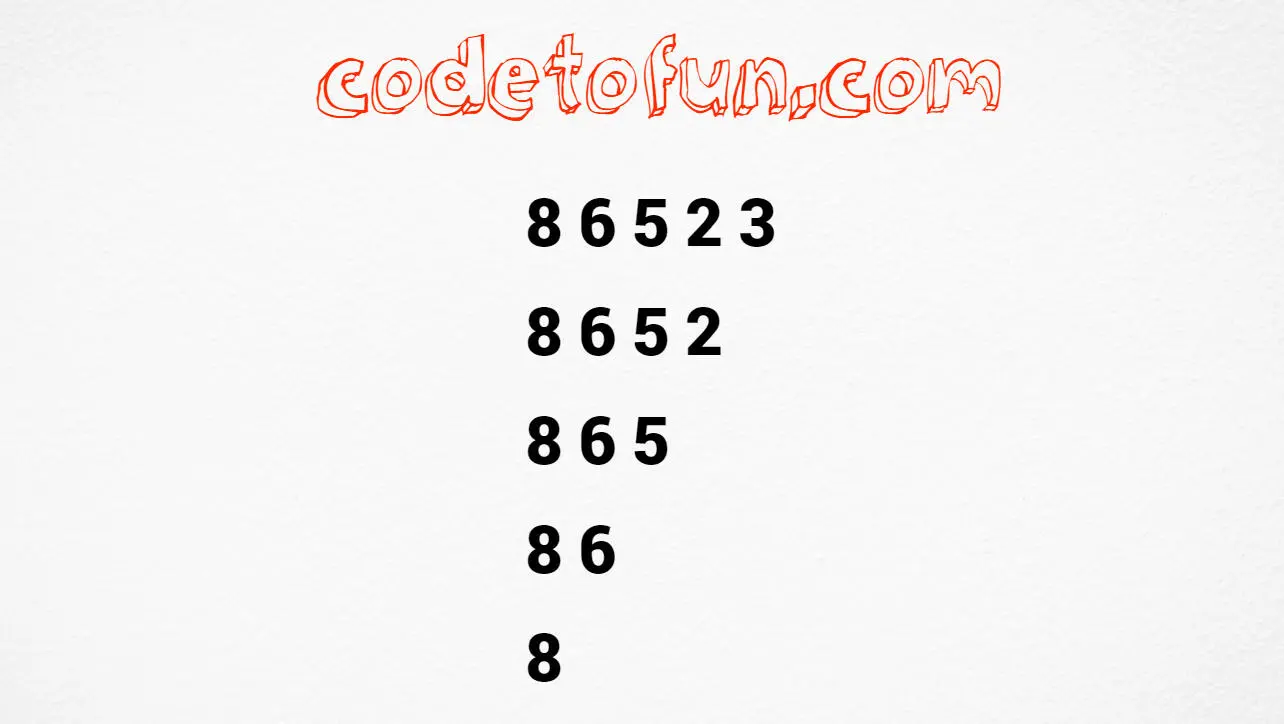
C++ Topics
- C++ Intro
- C++ String Functions
- C++ Interview Programs
- C++ Star Pattern
- C++ Number Pattern
- Number Pattern 1
- Number Pattern 2
- Number Pattern 3
- Number Pattern 4
- Number Pattern 5
- Number Pattern 6
- Number Pattern 7
- Number Pattern 8
- Number Pattern 9
- Number Pattern 10
- Number Pattern 11
- Number Pattern 12
- Number Pattern 13
- Number Pattern 14
- Number Pattern 15
- Number Pattern 16
- Number Pattern 17
- Number Pattern 18
- Number Pattern 19
- Number Pattern 20
- Number Pattern 21
- Number Pattern 22
- Number Pattern 23
- Number Pattern 24
- Number Pattern 25
- Number Pattern 26
- Number Pattern 27
- Number Pattern 28
- Number Pattern 29
- Number Pattern 30
- Number Pattern 31
- Number Pattern 32
- Number Pattern 33
- Number Pattern 34
- Number Pattern 35
- Number Pattern 36
- Number Pattern 37
- Number Pattern 38
- Number Pattern 39
- Number Pattern 40
- Number Pattern 41
- Number Pattern 42
- Number Pattern 43
- Number Pattern 44
- Number Pattern 45
- Number Pattern 46
- Number Pattern 47
- Number Pattern 48
- Number Pattern 49
- Number Pattern 50
- Number Pattern 51
- Number Pattern 52
- Number Pattern 53
- Number Pattern 54
- Number Pattern 55
- Number Pattern 56
- Number Pattern 57
- Number Pattern 58
- Number Pattern 59
- Number Pattern 60
- Number Pattern 61
- Number Pattern 62
- C++ Alphabet Pattern
C++ Number Pattern 60

Photo Credit to CodeToFun
C++ Number Pattern 60
Here`s a program that prints the above number pattern using C++ Programming:
#include <iostream>
using namespace std;
int main() {
int num = 86523;
while (num != 0) {
cout << num << "\n";
num = num / 10;
}
return 0;
}💻 Testing the Program
When you run the above program, it will print the following output:
86523 8652 865 86 8
🧠 How the Program Works
Let's break down the logic behind the code:
- #include <iostream>: This line includes the input/output stream library, which provides functionality to read input from the user and display output to the console.
- using namespace std;: This line allows us to use elements from the standard library (e.g., cout and endl) without explicitly specifying the namespace.
- int main(): This is the entry point of the C++ program, where the execution begins. The int before main indicates that the function will return an integer value.
- int num = 86523;: This line declares an integer variable named num and initializes it with the value 86523.
- while (num != 0): This is a while loop that will continue as long as the condition num != 0 is true. In other words, the loop will run until num becomes zero.
- cout << num << "\n";: This line outputs the current value of num to the console followed by a newline character (\n). It will print the value of num in each iteration of the loop.
- num = num / 10;: This line divides the current value of num by 10 and updates the value of num to be equal to the result of this division. This effectively removes the last digit of num in each iteration.
- The loop will continue to execute, displaying the updated value of num, and dividing num by 10 in each iteration until num becomes zero.
- When num eventually becomes 0, the loop condition num != 0 becomes false, and the loop terminates.
- return 0; This line signifies the end of the main function and indicates that the program has completed successfully. The 0 being returned is an indication of success (usually, a non-zero value is used to indicate an error or abnormal termination).
💯 Tips for Enhancement:
Explore the versatility of this pattern by adjusting its parameters. Whether you increase or decrease the size, tweak the spacing, or modify the characters used, each change opens up a world of possibilities, allowing you to customize and create your unique visual effects.
✔ Conclusion:
Creating visually appealing patterns is not only a fun endeavour but also a great way to enhance your programming or design skills. We hope this tutorial has inspired you to explore the world of creative coding. Share your creations with us, and let your imagination run wild!
🤗 Closing Call-to-Action:
We'd love to see your unique interpretations of the number pattern. Share your creations in the comments below, and don't hesitate to reach out if you have any questions or suggestions for future tutorials. Happy coding!
👨💻 Join our Community:
Author

For over eight years, I worked as a full-stack web developer. Now, I have chosen my profession as a full-time blogger at codetofun.com.
Buy me a coffee to make codetofun.com free for everyone.
Buy me a Coffee












If you have any doubts regarding this article (C++ Number Pattern 60) please comment here. I will help you immediately.